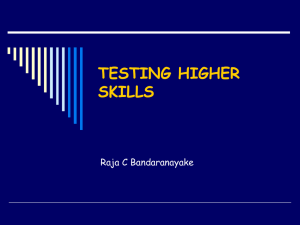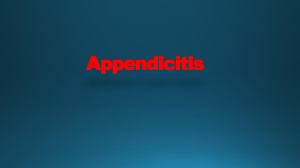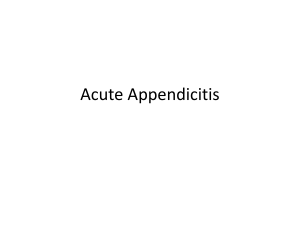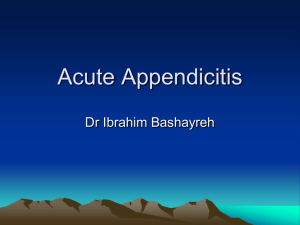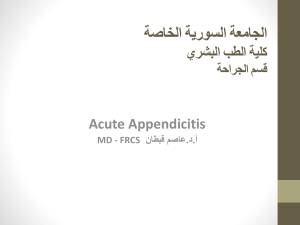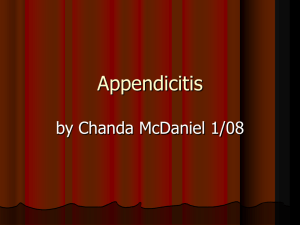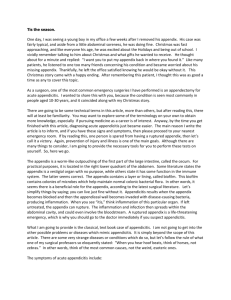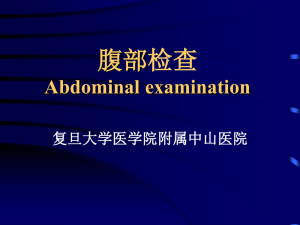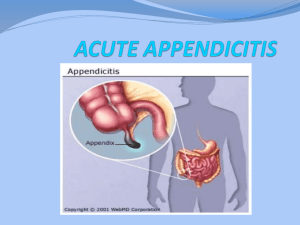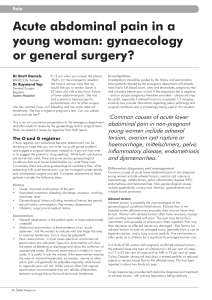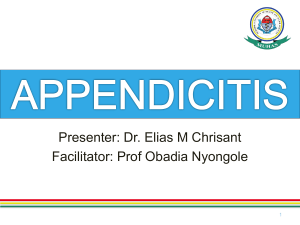Appendicitis Power Point Presentation
advertisement
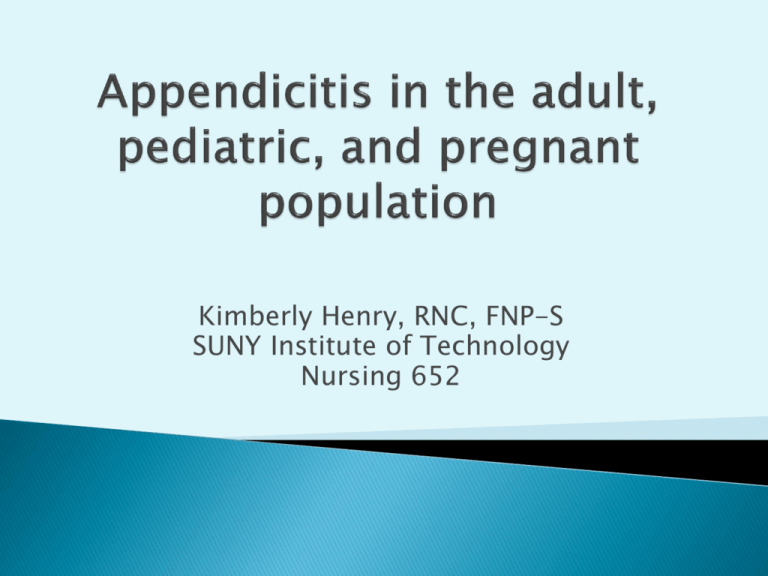
Kimberly Henry, RNC, FNP-S SUNY Institute of Technology Nursing 652 Thought to be obstruction of appendiceal lumen ↓ Inflammation ↓ Ischemia ↓ Perforation ↓ Abscess formation or Generalized Peritonitis Pediatrics Lymphoid hyperplasia due to infections Adults Fecaliths (hard fecal masses) Calculi Benign or malignant tumors 1st degree relative with history of appendicitis 10-19 year old age group Male (2:1) Intra-abdominal tumors Parasites Classic presentation consists of vague periumbilical pain which later migrates to RLQ as inflammation progresses (within 4-48hrs) May or may not have a fever Anorexia Nausea or/or vomiting (after the onset of pain) Pain which is exacerbated by walking or coughing Nonspecific signs: indigestion, flatulence, bowel irregularity, diarrhea, generalized malaise May have tachycardia and hypertension r/t pain and fever May display shallow breathing in an attempt to not cause pain Psoas sign: Pain when right thigh is extended (retrocecal appendix) as a result, patient may lie with knee bent to relieve tension on ilopsoas muscle Positive rebound tenderness Rovsing sign: RLQ pain when palpating LLQ Obturator sign: Right hip and knee flexed, then rotated internally stretching obturator muscle (pelvic appendix) McBurney’s sign: Pressure applied to McBurney’s Point Bowels sounds can be present, absent, or decreased Retrocecal appendix: may only produce dull abdominal tenderness but marked pain during rectal/pelvic exam Anterior appendix: Produces marked, localized pain in the right lower quadrant Pelvic appendix: Causes tenderness below McBurney’s point. Also will have pain during rectal/pevic exam GI: Gastroenteritis, IBD, Divertulitis, Ileitis, Cholecystitis, Pancreatitis, bowel obstruction, Intussusception, Crohn’s Disease, Gynecological: PID, Ectopic Pregnancy, Ruptured Ovarian Cyst, Tubo-Ovarian Cyst, Ovarian and Fallopian Torsion, Mittelschmerz, Endometriosis, Acute Endometritis Urological: Testicular Torsion, Epididymitis, Renal Colic, kidney stones, Prostatitis, Cystitis, Pylenephritis CBC with Diff: mild to moderate leukocytosis (10-20,000mcg/L) with a left shift of immature neutrophils U/A: may show hematuria and/or pyuria C-Reactive Protein (CPR)- elevation in CPR coupled with leukocytosis can be an indicator of appendicitis CT scan is the most widely used imaging modality, but should be used only when diagnosis is uncertain Ultrasound is reliable to confirm, not exclude, the diagnosis Migratory right iliac fossa pain 1pt Anorexia 1pt Nausea/Vomiting 1pt Tenderness in RLQ 2pts Rebound tenderness 1 pt Fever >37.3 1 pt Leukocytosis 2pts Shift to the left 1 pt 1-4 discharge 5-6 observation/admission >7 surgery The standard of care for treating appendicitis is appendectomy Preop: NPO, IV fluids, IV antibiotics Cefoxitin (1-2gms) Cefazolin (2g if <120kg 3g if >120kg) PCN and Cephalosporin allergy Clindamycin 900mg plus Gentamycin 5mg/kg Less likely to present with classic appendicitis signs Due to the enlarging uterus, McBurney’s Point may be located more toward the mid or upper right side of the abdomen Rebound tenderness and guarding may not be present (due to uterus size) An increased WBC is a normal finding in pregnancy, with the count rising to ~25,000 during labor Lack of migratory pain in 50% of patients Absent of anorexia, with 50% reporting they are hungry Infants may be lethargic, have increased irritability with movement, and may flex their hips for comfort Hoping on one foot or coughing usually elicits abdominal pain Neonates display temperature instability May limp or have right hip pain May have right sided pelvic pain or mass on palpation or rectal exam The adult list plus: Intussusception Intestinal Malrotation Torsion of the Omentum Hemolytic Uremic Sydrome Primary Peritonitis Henoch-Schonlein Purpura Sickle cell-disease UTI Perforation Sepsis Shock Death Peds: Rupture earlier and have a rupture rate of 15-60% Pregnant patients: 40% rupture rate and fetal mortality rate of 2-8.5% Geriatrics: Rupture rate of 67-90% Wound infection (increased risk if no prophylactic antibiotics) Intestinal obstruction Paralytic Ileus Incisional Hernia Preterm labor No heavy lifting (>10 lbs) or strenuous physical activity for 4-6 weeks May return to work 1-2 weeks S/S infection
